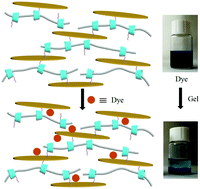Construction and efficient dye adsorption of supramolecular hydrogels by cyclodextrin pseudorotaxane and clay†
Abstract
Supramolecular hydrogels, which are usually used to develop excellent smart soft materials, are widely applied in miscellaneous fields due to their inherent reversible properties, unique functions and mechanical properties. Compared with covalently linked hydrogels, supramolecular hydrogels have advantages of easy preparation, stimulus responsiveness and good biocompatibility. Herein, after threading amino-modified β-cyclodextrins onto poly(propyleneglycol)bis(2-amionopropylether) (PPG-NH2) chains, the resultant pseudorotaxanes non-covalently interacted with a clay nanosheet (CNS) matrix to construct supramolecular hydrogels bearing negative charges, and the mechanical properties of these hydrogels were positively correlated with the number of amino groups on the pseudorotaxane. Significantly, these hydrogels presented good adsorption properties for cationic dyes. The adsorption capacity (Qe) of the hydrogels towards rhodamine B (RhB), crystal violet (CV), and methylene blue (MB) could reach 181–228 mg g−1, and most of the dyes were adsorbed within 5 min. Thus, these hydrogels may have potential applications in the field of waste water treatment.



 Please wait while we load your content...
Please wait while we load your content...